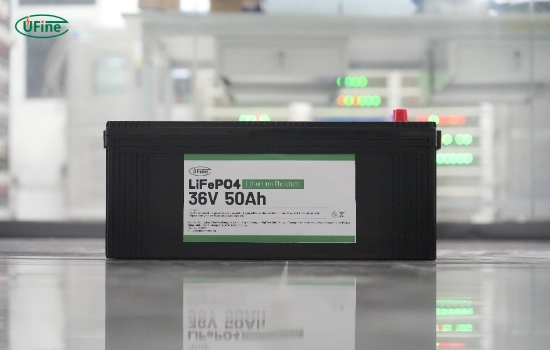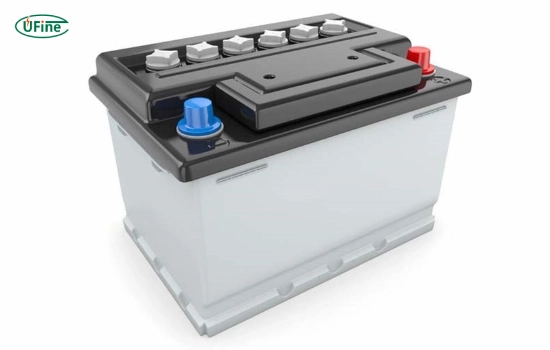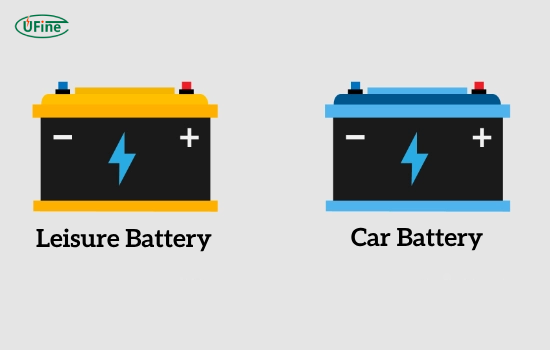Understanding the differences between leisure and car batteries is crucial when powering vehicles and recreational equipment. This article will provide a comprehensive overview of both types of batteries, their functionalities, and their applications. By the end, you’ll clearly understand which battery suits your needs.
Part 1. What is a leisure battery?
A leisure battery powers appliances in caravans, motorhomes, and boats. Unlike car batteries, primarily used to start engines, leisure batteries deliver a steady flow of electricity over extended periods. This makes them ideal for powering devices such as lights, refrigerators, and entertainment systems while the vehicle is stationary.
Key Features of Leisure Batteries
- Deep Cycle Design: Leisure batteries withstand multiple discharges and recharge. They can sustain lower charge levels without significant damage.
- Thicker Plates: Leisure batteries’ internal structure features thicker lead plates, which allow them to release energy slowly and withstand deep discharges.
- Maintenance-Free Options: Many modern leisure batteries, particularly lithium-based ones, require little to no maintenance, making them convenient for users.
Part 2. How do leisure batteries work?
Leisure batteries convert chemical energy into electrical energy through electrochemical reactions. When the battery is connected to a load (like a light or refrigerator), the chemical reaction releases electrons, which flow through the circuit, powering the device.
Charging Leisure Battery
Leisure batteries can be charged using:
- Solar Panels: A popular choice for campers and off-grid enthusiasts, solar panels can charge leisure batteries using renewable energy.
- Alternators: While driving, the vehicle’s alternator can recharge the leisure battery, especially if a split charging system is in place.
- Mains Power: When parked, use a standard electrical outlet to charge leisure batteries.
Part 3. Types of leisure batteries
Leisure batteries come in various types, each suited for different applications. Here are the most common types:
Standard Lead-Acid Batteries
These are the most traditional leisure batteries known for their affordability and reliability. They are suitable for basic applications but may require more frequent maintenance.
AGM (Absorbent Glass Mat) Batteries
AGM batteries are sealed and maintenance-free, making them ideal for users who want a hassle-free experience. They also have a lower risk of leakage and can handle deep discharges better than standard lead-acid batteries.
Lithium Batteries
Lithium batteries, particularly Lithium Iron Phosphate (LiFePO4), have gained popularity due to their lightweight design and high efficiency. They can be discharged deeper than lead-acid batteries without damage and have a longer lifespan.
Part 4. What is a car battery?
A car battery provides the high energy needed to start an engine. Once the engine runs, the car’s alternator takes over, supplying power to the vehicle’s electrical systems and recharging the battery.
Key Features of Car Batteries
- High-Cranking Power: Car batteries quickly deliver a significant amount of current, essential for starting an engine.
- Thin Plates: Car batteries’ internal structure consists of many thin lead plates, which maximize surface area for quick energy release.
- Limited Deep Discharge Capability: Car batteries do not handle deep discharges well. Frequent deep discharging can lead to sulfation, which permanently damages the battery.
Part 5. How do car batteries work?
Car batteries operate similarly, but their design focuses on providing a high current for short bursts. When you turn on the ignition, the battery sends electricity to the starter motor, which cranks the engine.
Charging Car Battery
Car batteries are typically recharged by:
- Alternators: The alternator replenishes the battery’s charge while the engine runs, ensuring it remains ready for the next start.
- Battery Chargers: When not in use, car batteries can be charged with a dedicated battery charger, especially during long periods of inactivity.
Part 6. Types of car batteries
Car batteries also vary based on their design and intended use. Here are the main types:
Standard Lead-Acid Batteries
These are the most common types of car batteries. They provide reliable starting power for most vehicles, are affordable, and may require regular maintenance.
AGM Batteries
AGM car batteries offer superior performance, especially in extreme conditions. They are sealed, maintenance-free, and can handle deep discharges, making them suitable for vehicles with high electrical demands.
EFB (Enhanced Flooded Battery)
EFB batteries serve vehicles with start-stop technology. They perform better than standard lead-acid batteries but are generally less expensive than AGM batteries.
Part 7. Differences between leisure batteries and car batteries
Leisure and car batteries differ in key aspects, including their primary use, discharge capability, plate design, cycle life, and maintenance requirements. Here’s a detailed comparison:
- Primary Use: Leisure batteries power vehicle appliances while car batteries start engines.
- Discharge Capability: Leisure batteries handle deep discharges, allowing users to deplete them to a lower charge level without significant damage. In contrast, car batteries manage only shallow discharges and should not frequently discharge to low levels.
- Plate Design: Leisure batteries feature thicker lead plates that enable slow energy release and withstand deep discharges. Car batteries, conversely, have thinner plates that maximize surface area for quick energy bursts needed for engine starting.
- Cycle Life: Leisure batteries are built to withstand multiple discharge and recharge cycles, making them suitable for applications that require frequent power usage. Car batteries have a limited cycle life and can degrade faster when subjected to deep discharges.
- Maintenance: Many modern leisure batteries, particularly lithium-based ones, are maintenance-free, reducing the hassle for users. Car batteries may require periodic maintenance, such as checking the electrolyte levels and cleaning the terminals.
|
Feature |
Leisure Battery |
Car Battery |
|
Primary Use |
Powering appliances in vehicles |
Starting the engine |
|
Discharge Capability |
Deep discharge capable |
Shallow discharge only |
|
Plate Design |
Thicker plates for slow discharge |
Thinner plates for quick discharge |
|
Cycle Life |
Designed for multiple cycles |
Limited cycles before degradation |
|
Maintenance |
Often maintenance-free |
It may require periodic maintenance |
Part 8. Choosing the right battery for your needs
When deciding between a leisure battery and a car battery, consider the following factors:
- Purpose: A car battery is the right choice if you need a battery to start a vehicle. Opt for a leisure battery to power appliances in a caravan or boat.
- Usage Patterns: Consider how often you will discharge the battery. If you frequently use deep discharges, a leisure battery is more suitable.
- Budget: While leisure batteries are more expensive, their longevity and efficiency may justify the cost over time.
Part 9. FAQs
-
Can I use a car battery in my caravan?
Using a car battery in a caravan is not recommended. Car batteries are not designed for deep discharges and can be damaged if used for prolonged appliance power. -
How long does a leisure battery last?
The lifespan of a leisure battery can vary. Still, depending on the type and usage, it can last anywhere from 3 to 10 years with proper care. -
What is the best type of leisure battery?
The best type of leisure battery depends on your specific needs. Lithium batteries are often considered the best due to their efficiency and longevity, but they come at a higher price. -
How can I extend the life of my car battery?
To extend the life of your car battery, ensure it is regularly charged, avoid deep discharges, and keep the terminals clean and corrosion-free. -
Do leisure batteries need to be replaced regularly?
Leisure batteries can be replaced only occasionally if appropriately maintained. However, they should be monitored for performance and replaced when they can no longer hold a charge effectively.
Related Tags:
More Articles

How to Choose the Best Floor Scrubber Battery for Commercial Cleaning?
Selecting the ideal floor scrubber battery ensures a long runtime, rapid charging, and minimal maintenance for efficient commercial cleaning operations.
Battery for Blower vs Battery for Leaf Vacuum: Which One Should You Choose?
Battery for blower vs leaf vacuum—learn the key differences in power, fit, and runtime to choose the right battery for your outdoor tool needs.
How to Choose the Right Battery for Blower?
Choosing the right blower battery? Consider voltage, capacity, chemistry & usage. This guide helps match the best battery for peak performance.
How to Choose the Best Insulated Battery Box for Lithium Batteries?
Choosing the Best Insulated Battery Box for Lithium Batteries? Discover key factors such as size, material, and safety for optimal protection and performance.
7 Critical Elements on a Lithium Battery Shipping Label
What must be on a lithium battery shipping label? Learn 7 key elements to ensure safety, legal compliance, and correct handling across all transport modes.






